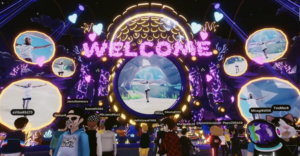There are many different use cases for virtual worlds, whether you are a creative person hoping to navigate the metaverse or a corporation trying to create immersive and engaging experiences for your customers.
What are three different use cases for virtual worlds that will certainly play a role in how the metaverse is accepted and received? Let’s examine three different scenarios where the metaverse can begin to play a critical role in everyday life.
Immersive gaming experiences
 Before the term “metaverse” became such a buzzword, video games were already technically creating their own metaverses. Games like Pokémon Go, Fortnite, and Roblox all basically had their own metaverses, where avatars can interact and engage with each other and users can build in these various worlds.
Before the term “metaverse” became such a buzzword, video games were already technically creating their own metaverses. Games like Pokémon Go, Fortnite, and Roblox all basically had their own metaverses, where avatars can interact and engage with each other and users can build in these various worlds.
Gaming is definitely a gateway to the metaverse, so video game developers will create various metaverse games to help entice players. Since there are billions of gamers, you can expect many people worldwide to enter the metaverse ready for unique gaming experiences.
Remote work and collaboration
 All around the world, more people are realizing they don’t want to return to a physical office at all. Instead, the rise of remote work has made it so that employees can remain productive while also working remotely or from home. Instead of a Zoom call, what if you can meet your fellow employees at a virtual office?
All around the world, more people are realizing they don’t want to return to a physical office at all. Instead, the rise of remote work has made it so that employees can remain productive while also working remotely or from home. Instead of a Zoom call, what if you can meet your fellow employees at a virtual office?
The metaverse can be an incredible tool when it comes to remote collaboration. Imagine an office in the metaverse where you can collaborate in real-time and use metaverse tools to help create objects, graphics, or presentations to help bring your vision to life.
Whether you’re a teacher, a graphic designer, or a developer, the metaverse can make it much easier to work with people all over the world. It can also cut costs by allowing entrepreneurs to pitch to investors in a metaverse office rather than spending money on travel.
Turning social media into virtual social communities
 The “metaverse” became one of the biggest business buzzwords in the world, but only after Facebook decided to rebrand to Meta. The rebrand made it clear: Facebook wants to create a metaverse as a way for them to expand their social media platform into virtual worlds. In the metaverse, there’s a new level of interactivity/connectivity possible.
The “metaverse” became one of the biggest business buzzwords in the world, but only after Facebook decided to rebrand to Meta. The rebrand made it clear: Facebook wants to create a metaverse as a way for them to expand their social media platform into virtual worlds. In the metaverse, there’s a new level of interactivity/connectivity possible.
You might already have connected with hundreds or thousands of friends and family members on Meta. But what if you want to check out a Gen Z fashion show? You might want to wear your best virtual clothes and head to the Gucci metaverse or the Balenciaga metaverse. You might also be looking for a job in an eventual Linkedin metaverse.
We know the metaverse can bring people together with similar interests. It’s also possible there will be hundreds of popular metaverses, each with its own community and serving a unique purpose.
More use cases for virtual worlds will emerge
There are already different metaverses, and one of the biggest issues will be which metaverses become more prevalent and powerful. It’s also important to realize that interoperability is one of the biggest obstacles to metaverse adoption. Other use cases for virtual worlds will emerge, but it’s hard to tell whether they will lean towards gaming, work, fashion, entertainment, art, or otherwise.
Will your virtual clothes transfer to every metaverse? If not, what does this say for the future of NFTs and digital scarcity? These questions will need to be answered in the near future if the metaverse is going to be a part of our daily lives.
About the Author

Michael Hearne
About Decentral Publishing
Decentral Publishing is dedicated to producing content through our blog, eBooks, and docu-series to help our readers deepen their knowledge of cryptocurrency and related topics. Do you have a fresh perspective or any other topics worth discussing? Keep the conversation going with us online at: Facebook, Twitter, Instagram, and LinkedIn.


